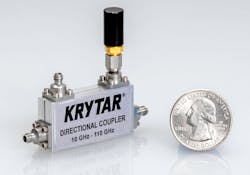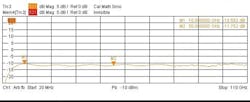Bandwidth is simply becoming a scarcer commodity as consumption of RF and microwave frequencies continues at an ever-quickening pace. As a result, many emerging wireless communications applications are reaching millimeter-wave (mmWave) frequency bands, creating greater demand for higher-frequency components needed in system and test-and-measurement applications.
One of these vital components is the directional coupler, which led longtime innovator Krytar to develop its model 1100110010 10-dB coaxial directional coupler with impressive 100-GHz bandwidth, from 10 to 110 GHz. It maintains low loss across that wide bandwidth, providing a single coupling solution for many of the emerging applications at mmWave frequencies.
Three-port directional couplers such as the model 1100110010 (Fig. 1) are designed to generate two signal paths from an applied input signal. Directional couplers are often designed with a pair of adjacent transmission lines, such as microstrip or stripline transmission lines. In this architecture, one of the transmission lines is the main or through signal path with most of the power; the transmission line alongside it is the coupled line with one terminated port, often in a load resistor.
1. Model 1100110010 is a compact 10-dB directional coupler with low loss and high directivity from 10 to 110 GHz.
Ideally, the output-power level of the mainline signal would be reduced very little—only by the amount of signal power coupled from the input signal. However, normal insertion loss accounts for some additional loss of mainline power. The power level of the second output signal—the coupled signal path—is reduced by the coupling factor of the coupler along with any insertion loss associated with that signal path. Signal interfaces, such as coaxial connectors, will also contribute to some loss of initial signal power.
Directional couplers are designed to operate within a well-matched system, such as 50 Ω, promoting smooth signal flow from a signal source, through the coupler’s input port, and through the output port to additional components in a system, such as a signal analyzer in a test system. Again, in real-life applications, some amount of impedance mismatch is inevitable, and signal power will be reflected at impedance mismatches. This results in an increase in return loss as signal power is sent back through the directional coupler, often dissipated as heat.
In designing directional couplers for practical bandwidths, such as 10 GHz, computer modeling and attention to design details help minimize causes of signal loss. Perhaps what makes the performance of the model 1100110010 directional coupler is that it’s consistent across a 100-GHz bandwidth—not just in loss behavior, but in coupling, VSWR, and other critical parameters that gauge a directional coupler’s usefulness.
Broadband but Consistent
The model 1100110010 directional coupler is only 2.31 in. long (1.55-in. package length with two 0.38-in. long coaxial connectors) and 0.80 in. wide. It weighs a mere 1.2 oz. and is equipped with 1.0-mm female coaxial connectors. It’s designed as a directional coupler with 10-dB nominal coupling and extremely flat coupling. Coupling that’s flat within 1 or 2 dB is generally considered good for a coupler with one-tenth the bandwidth. But the model 1100110010 directional coupler exhibits nominal coupling of 10 ±1.5 dB from 10 to 90 GHz (Fig. 2), only falling to a slightly wider coupling window of 10 ±1.8 dB from 90 to 110 GHz for the smallest-wavelength signals in its range.
2. The model 1100110010 directional coupler maintains flat 10-dB coupling across a wide 100-GHz bandwidth.
The mainline insertion loss, which includes the power coupled from that line (roughly about 0.5 dB), is only 5.5 dB across the full bandwidth. The maximum VSWR is 1.80:1 at any port 10 to 50 GHz and 2.50:1 at any port 50 to 110 GHz. The directional coupler is rated for maximum continuous wave (CW) of 20 W across the full frequency range and peak power of 3 kW for pulse widths as wide as 100 µs, depending on pulse repetition interval (PRI) and pulse repetition frequency (PRF).
The directional coupler achieves frequency sensitivity (amplitude flatness) of typically ±1.25 dB from 10 to 90 GHz and a still-respectable ±1.80 dB from 90 to 110 GHz. It provides directivity of at least 10 dB from 10 to 55 GHz and at least 7 dB (and typically 10 dB) at higher frequencies from 55 to 110 GHz. For applications requiring multiple couplers on multiple channels, such as high-frequency antenna beamforming systems, the unit-to-unit coupling tolerance (coupling consistency from unit to unit) is also quite good, within ±1.50 dB across the full bandwidth from 10 to 110 GHz.
Broadband directional couplers such as the 1100110010 support a growing number of applications at mmWave frequencies. The component meets MIL-C-15370 environmental requirements for military applications. It will prove useful for power monitoring and leveling in many different systems, including antenna beamforming systems, electronic-warfare (EW) systems, electromagnetic-compatibility (EMC) testing, radar systems, and wireless communications systems.
When combined with a relatively “narrowband” directional coupler such as the model 100312410, which is a 10-dB coupler with ±1-dB coupling flatness from 0.3 to 12.4 GHz, a total frequency range of 300 MHz to 110 GHz can be covered with consistent directivity, low mainline loss, and excellent coupling flatness. The combo would thus meet many present and future test-and-measurement industrial and military applications, and even well beyond the current requirements of emerging commercial mmWave applications such as 5G cellular communications and advanced driver-assistance system (ADAS) front and rear radar systems.
Krytar, 1288 Anvilwood Ave., Sunnyvale, CA 94089; (408) 734-5999, FAX: (408) 734-3017, (877) 734-5999.



